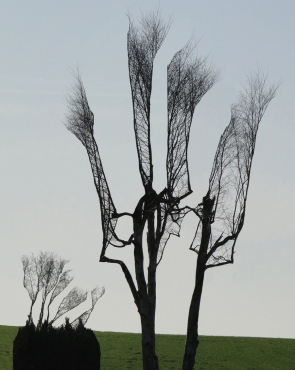Stefan Barton – Woodcuts
I am not a photographer. I mostly paint and draw. I really only take pictures with a camera if I feel I have to. I do it because I think nobody else would. The images are surprises I find in nature, in artifacts and in the play of light and shadow on some sort of topography. There are pictures of rips in plastic-foil glued to window panes, cracks in concrete walls, shriveled and nevertheless sprouting vegetables, light coming through glass-bricks, cracks in floating ice sheets on a river – and trees. What is different about the following tree pictures is that I manipulate them with my computer. Read on and find out why.
On a random road-trip through the countryside one of us got car-sick and we stopped for a short break. I got out of the car and walked around a little bit, eager to continue with the driving. Then I noticed something odd in a pairing of trees in front of the wall of some dilapidated and rather ugly farming-compound: nothing of importance, just a vague geometric sensation, an aesthetic challenge presented by the coincidental arrangement of lines and spaces. I debated with myself, but then got the camera out of the car and took a picture. I wanted to preserve the sight and find out if the vision would hold up on the computer, in a different environment, at a different time…
Some weeks later, I stood at the living-room window, staring at a row of far away linden trees. Again it took me quite a while to decide to get the camera, feeling a little silly. A hint of dancing, floating, naked figures, headless…
Another tree I could see from the same window, looking back at me somehow…

Walking in the countryside, armed with camera. The realization that in a forest, in small groupings and single trees, there are countless perspectives, countless compositions of trunks, branches and twigs. I would sometimes run around among the trees for hours, circling them, walking away, getting nearer, studying the bodies, arms, faces, eyes. I could imagine seeing myself from a distance: some weirdo with a camera running randomly around in the forest, obsessed with something invisible in the canopies, in the bark of tree trunks, stumbling, unaware of the path, spellbound, unable to look away. Or standing motionless for minutes, seemingly lost in thoughts.
Afterwards, the downloading of selected images, manipulations with software. Careful cutting and deleting of content, rearranging, little alterations, leaving authenticity to a certain extent intact, the taste of the original randomness, a sense of believability, the possibility of the composition. Simultaneously creating an odd shift in reality, a perforation of it.
The manipulations leading to something recognizable, hinting at something familiar, classifiable, interpretable.
Is there something in forestscapes that wants to be seen; are there hidden images in trees, manifestations, truth in observation?
The way of the wood – branching, the dendritic ramifications – is in reality too chaotic for us to recognize the true emergent and complex structure of trees. It is chaos – and self-organization. A tree is in its slowness something like a frozen fractal. But it is slow only to us. In its own temporal reality it grows rampant, shooting upward waving about greedily for light, competing for height and size. The procession of days is a flicker.
There is beauty in trees. They are reassuring and steadfast. But they are also mysterious, incomprehensible. One can, as in clouds, choose to see metaphorical images, maybe meaning. The barren treetops and the geometry of wood transcend the apparently mindless growing-ons and sproutings. One can refine it, purify it, even show the absurdity of it.
Wood doesn’t blush.

Stefan Barton resides in a village near Hamburg, Germany where there are many patient trees, but he spent 20 Years in the US (San Francisco and Boston Area). He works on paintings, drawings and printmaking. Once in a while he is transfixed by taking pictures and manipulating these in a peculiar way. To see more of his images contact Stefan (stefan.bartongmail.com ) visit http://clex-werk.blogspot.de/ or look at a book:


















